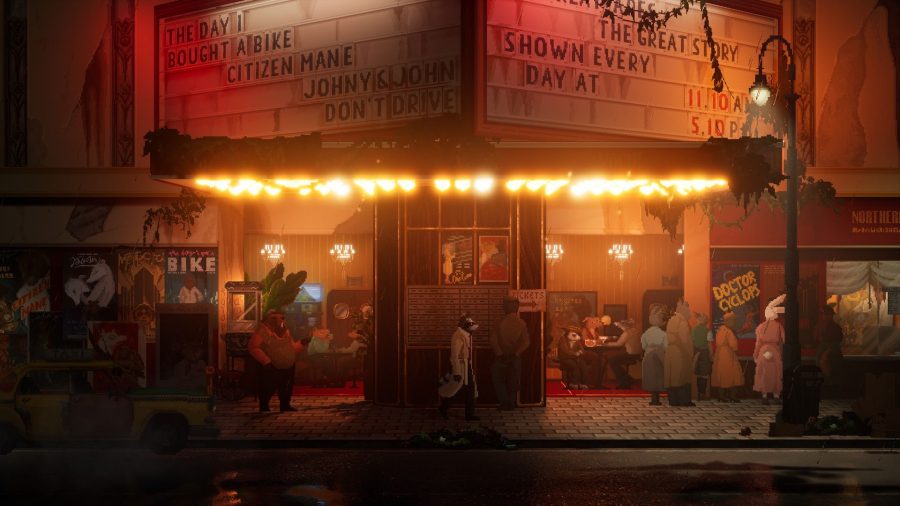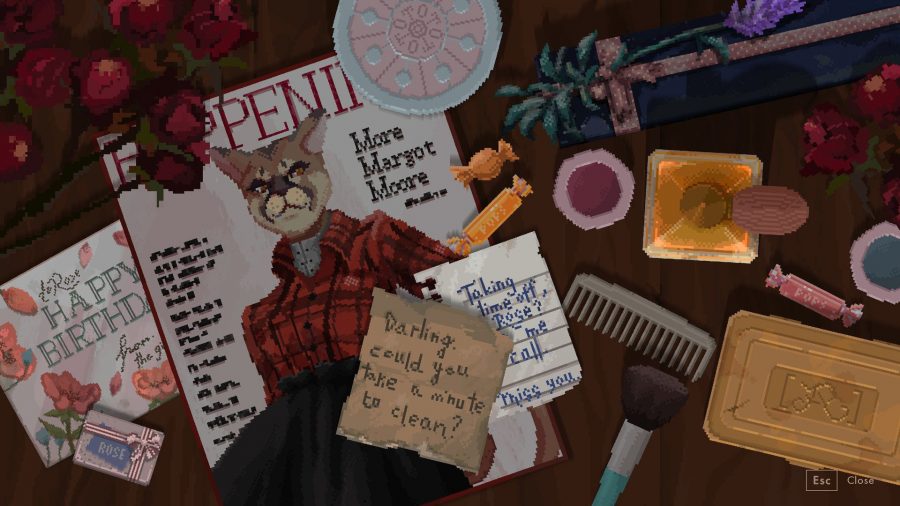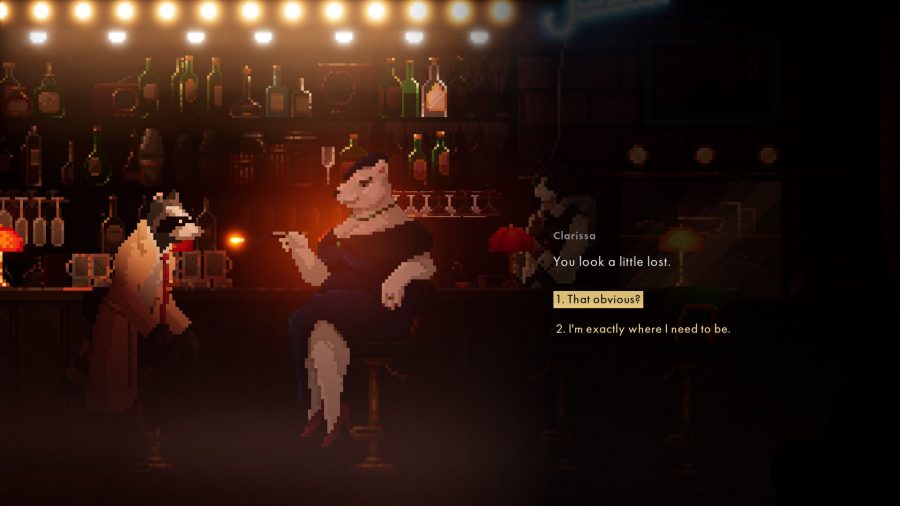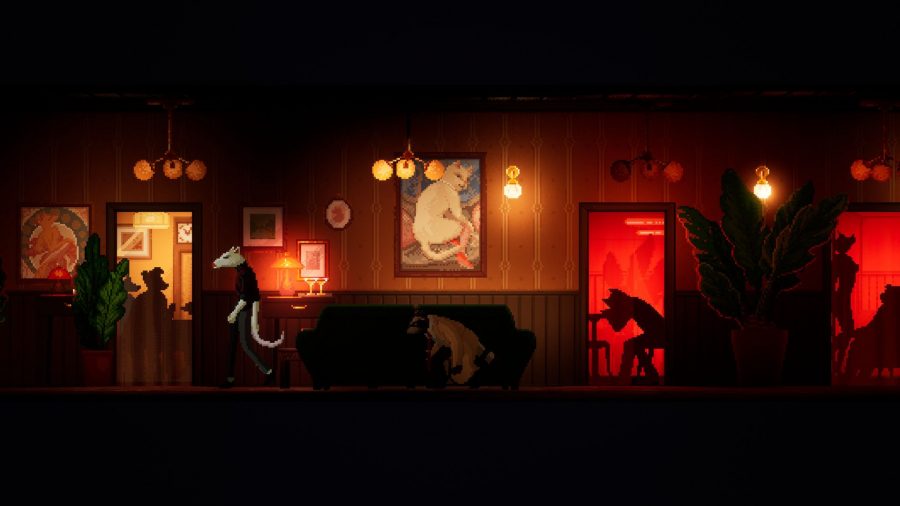We first featured Backbone, a pixel art noir adventure set in Vancouver and starring a private investigator who happens to be a raccoon, almost exactly two years ago. The project has undergone a number of changes since then which speak to the tumult of a new studio making its first game.
“We went through two instances of severe crunch and burnout: in preparation for the Kickstarter campaign in 2018, and then before and after the Prologue was released in 2019,” studio co-founder Aleksandra Korabelnikova laments. “It’s extremely important to us that this will not happen again. Almost all the challenges we faced could have been alleviated with proper planning.”
Korabelnikova is narrative designer and marketing director, but also wore admin and project management hats. “It was really too much to handle. There were instances when the team was lost in the sea of tasks, there was no proper communication between ‘departments’, and constant shifting of deadlines really sunk our morale at times.”
Publisher Raw Fury picked Backbone up in February this year, enabling the team to hire a dedicated project manager and refocus on their wellbeing. “Our main goal as a team is to stay healthy and happy, and release a full game in 2021. We have very simple but strict rules – work whenever you want, always have a plan, unlimited paid days off, and obligatory vacations. We all work from home too, in five different time zones, so it’s very important to be gentle, kind and supportive to each other. This new set of rules and goals is really the biggest change between our studio in 2018 and 2020.”

The game itself has had to change too. A scent system that would’ve used Unreal’s particle effects to enable you to find clues through sense of smell, or even mask your own scent by wallowing in rubbish – remember, you’re a raccoon – has had to be scrapped entirely. “We’ve completely scratched that gameplay mechanic,” lead developer and composer Nikita Danshin admits. “Our team was half the size it is right now in 2018, and we didn’t have the capacity to prototype the stealth and other puzzles properly using it. It’s a great idea, but hard to implement in a 2D environment. We decided to polish other parts, like puzzles, the dialogue system, and narrative.”
It’s a tale as old as game development itself. This is a young medium, the possibilities of which have yet to be fully explored and are nonetheless growing as technology – such as the Unreal Engine – continues to evolve. It attracts creative types eager to realise those possibilities, but game development is hard, and ambitions, sadly, must be tempered.
One aspect of Backbone that couldn’t simply be scrapped is its perspective. This is a ‘2.5D’ game, in the sense that it’s played from a 2D perspective but is technically 3D in the engine, in the sense that it uses a mix of 2D and 3D assets, arranged at varying levels of depth.
This has been a challenge from the outset of the project, as our last piece makes plain. Though Unreal Engine does offer a tool to help with 2D game development – Paper 2D – it’s been somewhat neglected as the engine has evolved, and doesn’t always play well with the 3D elements EggNut wanted to use – the devs had to “bring in a bunch of side plugins” to properly bolster its functionality, Danshin says.
Since we last spoke, however, the team has come a long way on this challenge. “We’ve upgraded our pipeline in a lot of ways,” Danshin says. “We use a lot of optical illusions to make it seem 3D, like using parallax with an enormous number of layers, changing the field of view, stretching planes, or drawing objects in predetermined perspectives. We don’t use a lot of 3D objects, as they draw too much attention from the scene and make all the other sprites look flat.”
It’s a reminder that if our medium is going to realise its potential, technologies like Unreal Engine must not only unlock new, far-flung possibilities, but economise the basics and bring them within reach of more developers – raising the floor as well as the ceiling, as it were. And although EggNut has identified some ways in which Paper 2D could be improved, Unreal Engine does aspire to do exactly this, not only with a suite of other tools, but through its marketplace of assets and its developer community – an unparalleled network of mutual support to help indies get to grips with Unreal.
More like this: The best adventure games on PC
“The marketplace sometimes brings you the solutions for issues that wake you up at night,” Danshin says. “And it’s great to see the community thriving and being so helpful to each other. In general UE4 is very versatile, and if you dig hard enough, it’s possible to find workarounds for almost any issues or undeveloped features.
“Some solutions included turning Paper2D sprites into regular 3D planes, allowing us to start baking lightmaps onto sprite surfaces and have static lighting bounce off surfaces and affect the volumetric lightmap. We made some custom deferred lighting and replaced some shadows with decals, so eventually we overcame most of the struggles. We gave a talk during Unreal Dev Days on how we do it, so that other teams could use our techniques or maybe improve on them.”
It’s getting easier to see why EggNut found this particular project so challenging – and this is before we get into the design difficulties in adapting stealth mechanics for the 2D perspective. “There’s a reason you don’t often see stealth in 2D games,” Danshin says. “Having only two planes to represent the environment already creates restrictions – how do you hide from enemies? How do they spot you?, etc.”
Other games have achieved this by creating space in their levels through extreme verticality, but again, this wasn’t an option for EggNut. “Backbone does not have verticality. We had to create additional adventure-like puzzle logic around stealth and also limit aggressive interactions with enemies, basically prohibiting failstate to keep the player in the same emotional space.”
It’s easy to see that a noir detective story set in a real-life city and with a naturalistic feel – apart from the anthropomorphic animals, of course – wouldn’t lend itself to vertiginous platformer-style level design. You’d think that such bold choices in environment and character design would be made very deliberately, but as it turns out, they emerged quite by accident. ‘Vancouver never plays itself’ is a phrase in the film world, referring to the fact that the city has stood in for dozens of others around the world as filmmakers flock to Canada, drawn by its generous tax credits scheme. Galvanised by this saying, Danshin says it was a “no-brainer” to set Backbone in EggNut’s home city of “Vancity” when they “figured out that a noir game was emerging in our brains. It has a great – and by great I mean terrible – history during the 20th century that is very much comparable to ‘classic’ cities of noir.”
And the anthropomorphic animals? “Also an accidental choice that moved towards an elaborate style: one day, a bunch of raccoons stormed my compost bin in Vancouver, so I had to scare them off with a trumpet. We just couldn’t stop laughing about it, and it inspired us to start writing a noir story about a raccoon detective in a dystopian world. Dystopia comes naturally to us, as a lot of our team members grew up in post-soviet countries.”
Backbone is due to release next year, but you can sample the experience with Backbone: Prologue, a, well, prologue that’s free-to-play and available on Steam now. Unreal Engine 4 is now free. Unreal Engine 5 is due to release next year.
In this sponsored series, we’re looking at how game developers are taking advantage of Unreal Engine 4 to create a new generation of PC games. With thanks to Epic Games and EggNut.





